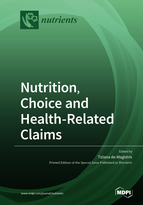Nutrition, Choice and Health-Related Claims
A special issue of Nutrients (ISSN 2072-6643).
Deadline for manuscript submissions: closed (31 October 2019) | Viewed by 95359
Special Issue Editor
Special Issue Information
Dear Colleagues,
The appearance and development of chronic diseases also known as non-communicable diseases (NCDs) has become one of the most common causes of deaths not only in the developed countries but also in the developing ones. Scientific evidence show that food consumption is one of the main causes that increases the risk of developing an NCD. In this context, policy makers have developed various intervention instruments to promote healthy diet and that lead to healthy habits and thus ensure the welfare of citizens. One of the mechanisms introduced to ensure more informed food purchases that lead to healthier diets is to provide information on the nutritional and health properties that certain food possess. This information is transmitted to consumers through different nutritional and health claims. Despite the high presence of health-related claims in the retailing sector, previous literature indicates that although people understand them, not many consumers report to use them. Hence, more research is needed to explore consumer behavior and food choices for food products that carry nutritional and health information and thus promote sustainable healthy eating.
The special issue deals with the role of nutritional properties and/or health-related claims of food products on welfare of citizens, choice preferences, choice behavior, healthy eating and healthy diet and, the willingness to pay. Papers addressing other interdisciplinary approaches, such as social psychology, food science and food marketing are also welcomed.
Dr. Tiziana de-Magistris
Guest Editor
Manuscript Submission Information
Manuscripts should be submitted online at www.mdpi.com by registering and logging in to this website. Once you are registered, click here to go to the submission form. Manuscripts can be submitted until the deadline. All submissions that pass pre-check are peer-reviewed. Accepted papers will be published continuously in the journal (as soon as accepted) and will be listed together on the special issue website. Research articles, review articles as well as short communications are invited. For planned papers, a title and short abstract (about 100 words) can be sent to the Editorial Office for announcement on this website.
Submitted manuscripts should not have been published previously, nor be under consideration for publication elsewhere (except conference proceedings papers). All manuscripts are thoroughly refereed through a single-blind peer-review process. A guide for authors and other relevant information for submission of manuscripts is available on the Instructions for Authors page. Nutrients is an international peer-reviewed open access semimonthly journal published by MDPI.
Please visit the Instructions for Authors page before submitting a manuscript. The Article Processing Charge (APC) for publication in this open access journal is 2900 CHF (Swiss Francs). Submitted papers should be well formatted and use good English. Authors may use MDPI's English editing service prior to publication or during author revisions.
Keywords
- non-communicable diseases (NCDs)
- Health-related claims
- Functional and novel foods
- Consumer Preferences
- Consumer behaviour
- Sensorial analysis
- Consumer traits
- Nutrition
- Healthy eating
- Healthy diet
- Consumption







